Brooks Catamount 3 Review (2024): Unmatched for Short Trails?
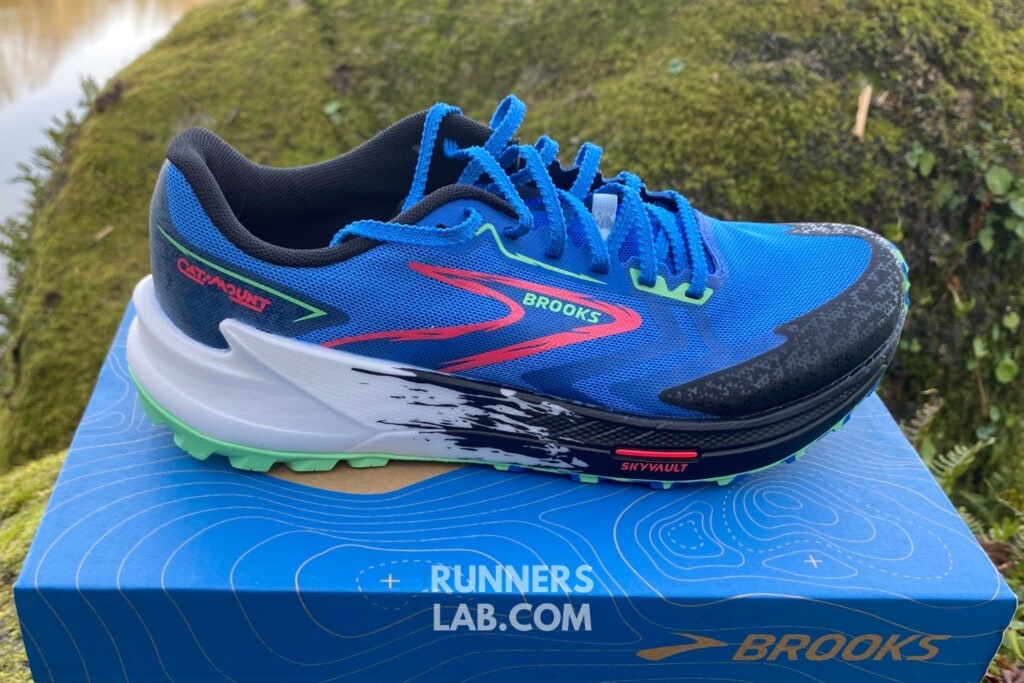
Our Verdict
An excellent, versatile trail running shoe, ideal for competition performance.
Don’t have time to read the full review? Here’s what you need to know.
The Brooks Catamounts are back for a third edition, after a highly successful second version. The brand has opted for continuity with the same technologies, but with a few modifications.
The midsole technology is once again DNA Flash foam with nitro-injection. Combined with the Pebax-based SkyVault trail plate in Pebax, the shoes offer a highly responsive ride while retaining great versatility.
The mesh upper is single-layered to be straightforward, providing a comfortable, snug fit. There are also reinforced pieces for added protection. For the outsole, TrailTack Green Rubber technology has already proved to be highly effective, notably with the Brooks Cascadia 17. It doesn’t disappoint and ensures excellent traction on all terrains.
All in all, the Brooks Catamount 3 is a success, making it one of the best trail running shoes for short to intermediate distances.
Please read our full review of the Brooks Catamount 3 for more information.
PROS
- Versatile, high-performance shoe
- Excellent traction on all surfaces
- Responsive cushioning
- Good durability
- Comfortable upper that fits snugly around the foot
- Effective rock plate for propulsion and protection
CONS
- Fits a little narrow in the forefoot for some runners
- Cushioning may be insufficient over long distances depending on your preferences
Introduction
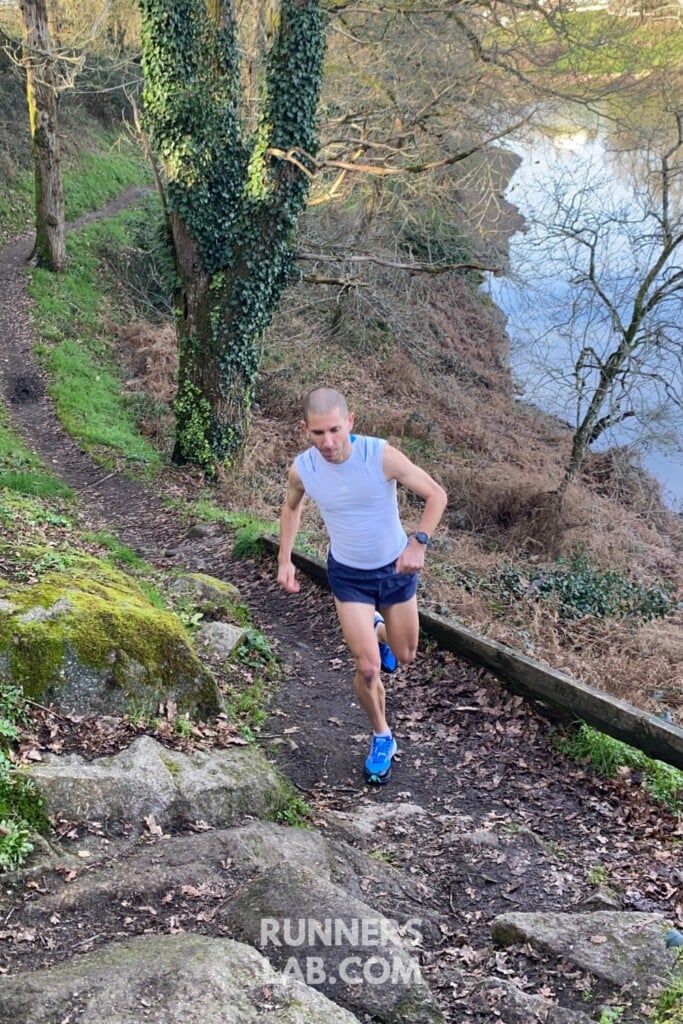
Brooks is one of the biggest running shoe brands in the USA. In the trail running category, the brand took a little longer to convince specialists. But it succeeded with models like the Cascadia.
However, the brand lacked a more responsive model in its range. The Catamount is exactly that. However, the first version was underwhelming and we had to wait a v2 for the series to really come together and become highly acclaimed.
So let’s take a look at the Brooks Catamount 3 in this analysis based on over 200 km/120 miles of test runs put into perspective with the insights from other reviews.
Grip
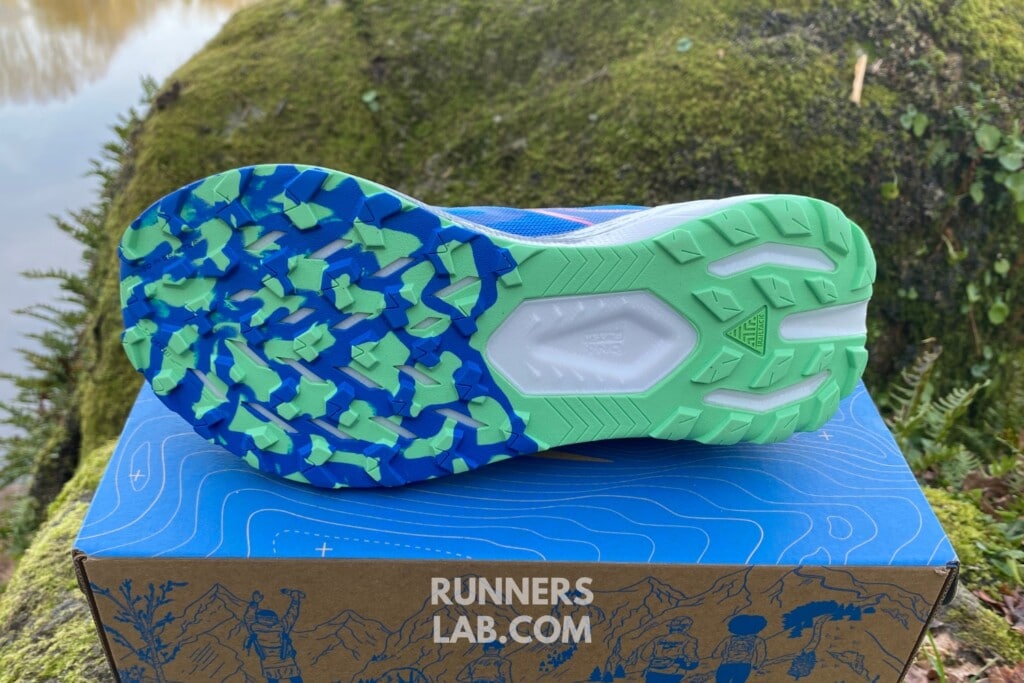
Visually, it’s hard to see any difference between the outsoles of versions 2 and 3. This is quite logical, given that the Catamount 2 was so effective and well received. However, there are two key differences.
First, the size of the lugs has been reduced from 4 mm to 3.5 mm. Second, the TrailTack Green rubber uses 25% of recycled materials, so the composition is different. Despite this, performance is quite similar. The coverage is the same, with lugs mainly in the heel and forefoot and fewer in the midfoot. The aggressive design–a near-losange shape– and direction are the same to maximize grip.
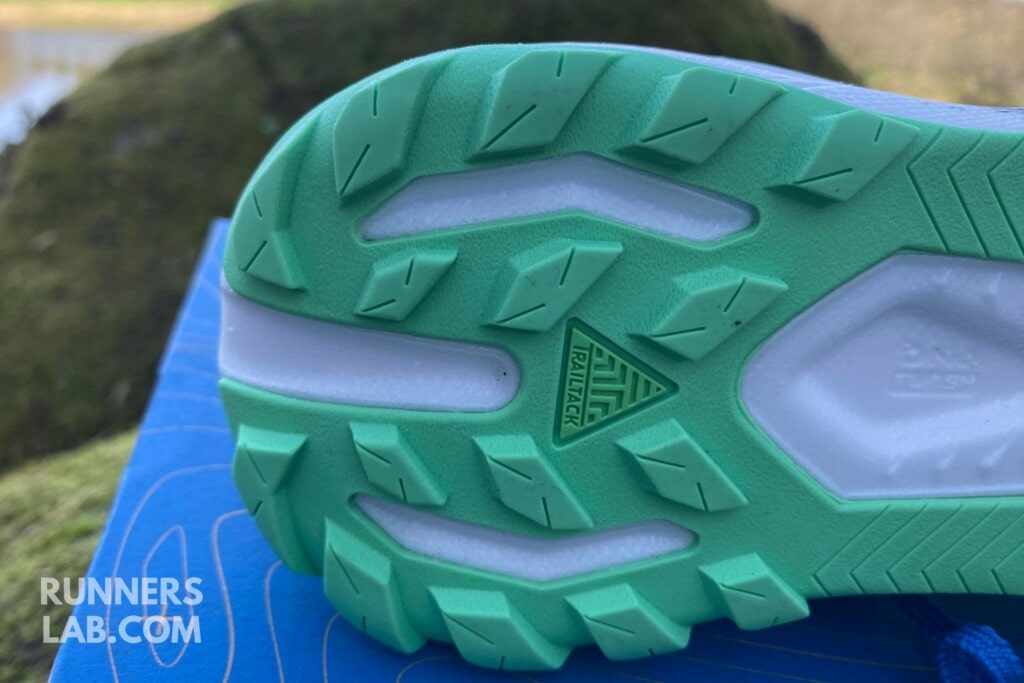
The grip is very good, and it’s hard to fault the shoe on either technical trails or slippery surfaces like wet rocks. Also, the strategically placed grooves ensure good flexibility while the rock plate protects the foot from sharp elements on your path.
The only point concern is with the reduced size of the lugs. Now at 3.5 mm, some testers would have preferred to keep 4 mm or maybe even go for something deeper like 4.5 or 5 mm (like on the Hoka Speedgoat 5) for a more powerful grip, especially in the mud.
Types of terrain
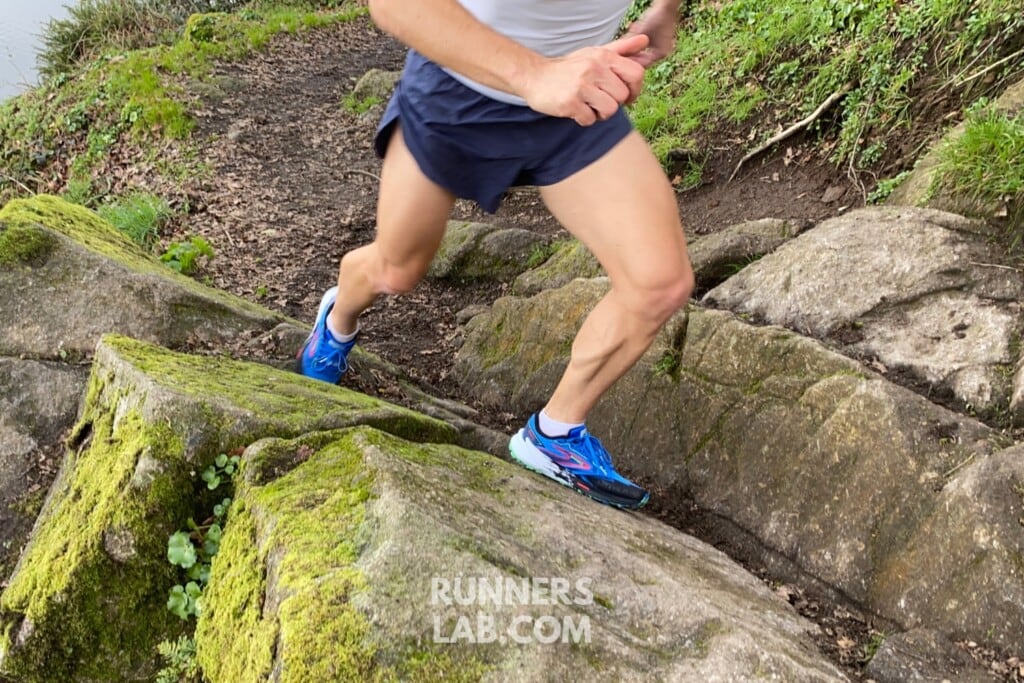
Overall, the Brooks Catamount 3 is at ease on most technical terrains, dry/compact and wet/loose ground alike. Rocky terrains are also a good use case for the Catamount 3 and I had no issues with the short snowy sections I encountered on my runs.
As mentioned, some testers felt the grip was not as good as on the previous version–they attribute this decrease in performance to the new compound and the shorter lugs. However, I found it safe in all conditions. Also, the advantage of this new configuration is to prevent mud from accumulating in the outsole. It’s also more comfortable to alternate with road sections.
Cushioning
The DNA Flash was such a hit that we imagine it was hard for Brooks to consider changing it. And indeed, why fix a good thing? This nitrogen-infused EVA foam uses a process that makes this trail shoe much lighter with a better energy return.
The underfoot feel is fairly firm, but not excessively so. The ride remains pleasant.
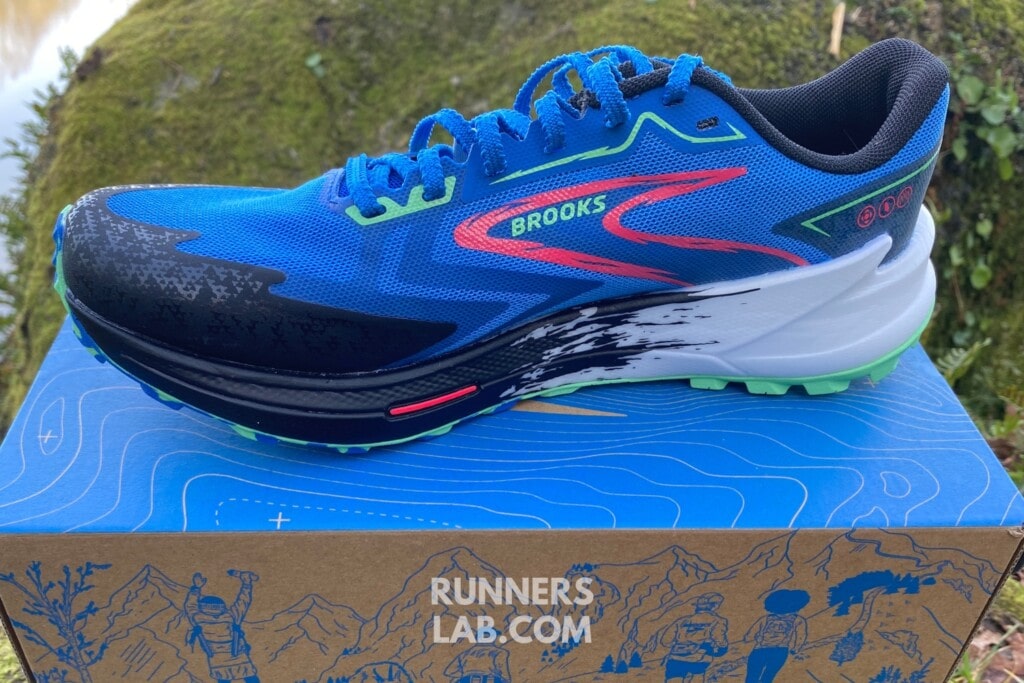
The SKYVAULT rock plate performs protects the foot and help with propulsion. At toe-off, when pushed, the plate bends and snaps back into place. This provides excellent stability and flexibility, especially on descents and hills.
With a 28-mm heel stack height (22 mm in the forefoot), Brooks has put the emphasis on making its Catamount lightweight. Despite this, the brand claims shock absorption to be sufficient for long distances between 50 and 100 km (30-60 miles). I think it will depend on the runner’s experience and personal preferences. We can confirm it’s quite suitable for short and intermediate distances, but beyond that it’s up to you!
Also, watch out for the low 6-mm heel-to-toe drop. It’s becoming standard with trail shoes due to the success of Hoka, but it may still take some getting used to if you normally run with higher-drop shoes.
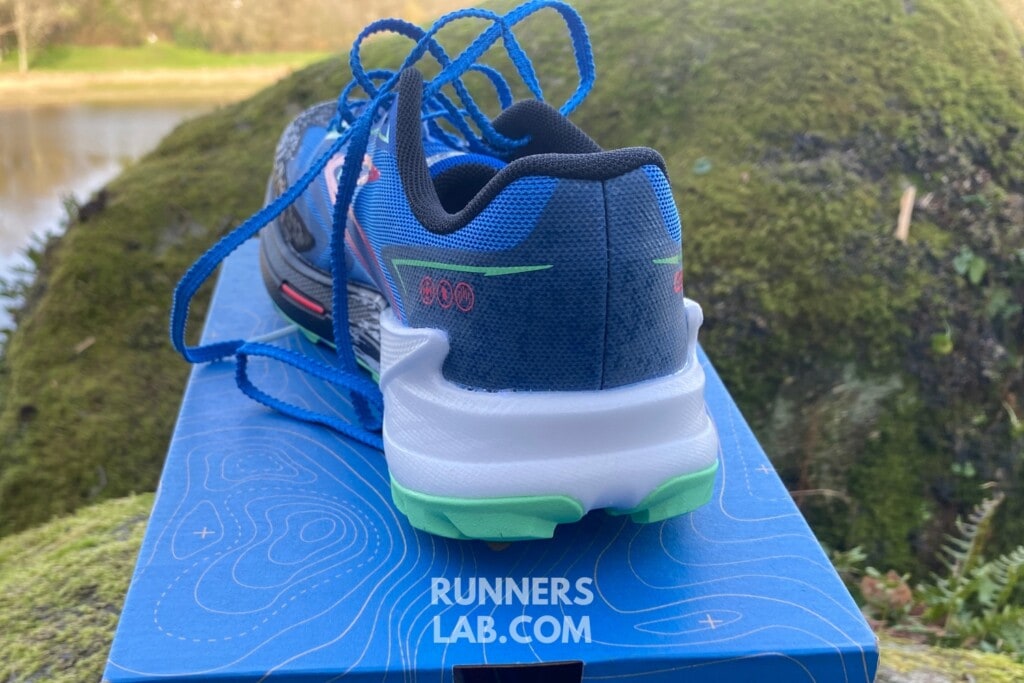
Energy return
With a weight of 246 g/8.7 oz in 42, the Brooks Catamount 3 is much lighter than its predecessor. Responsiveness is better–that’s the main selling point of this model right there!
The bounce itself is not so high because of the foam’s firmness, but you feel a subtle forward propulsion as you pick up the pace. Like other trail runners, I didn’t feel the SKYVAULT plate helped with propulsion as claimed by the brand. However, it did help when running uphill.
The rocker is moderate, but shoe’s overall performance design ensures smooth transitions.
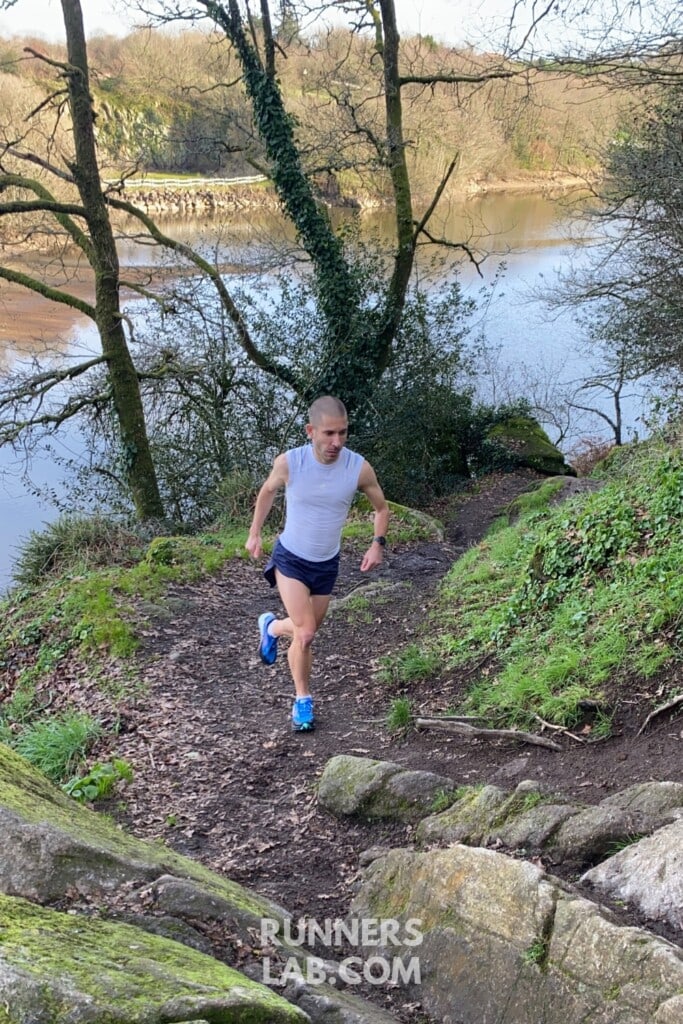
Foot Lockdown
Let’s give it up for Brooks: the mesh upper is a masterclass! And yet, the equation was complex: how to combine lightness, lockdown, comfort and protection?
To make the shoe lighter and more responsive, Brooks opted for a single-layer engineered mesh. It’s very comfortable, with just the right amount of padding in all the right places.
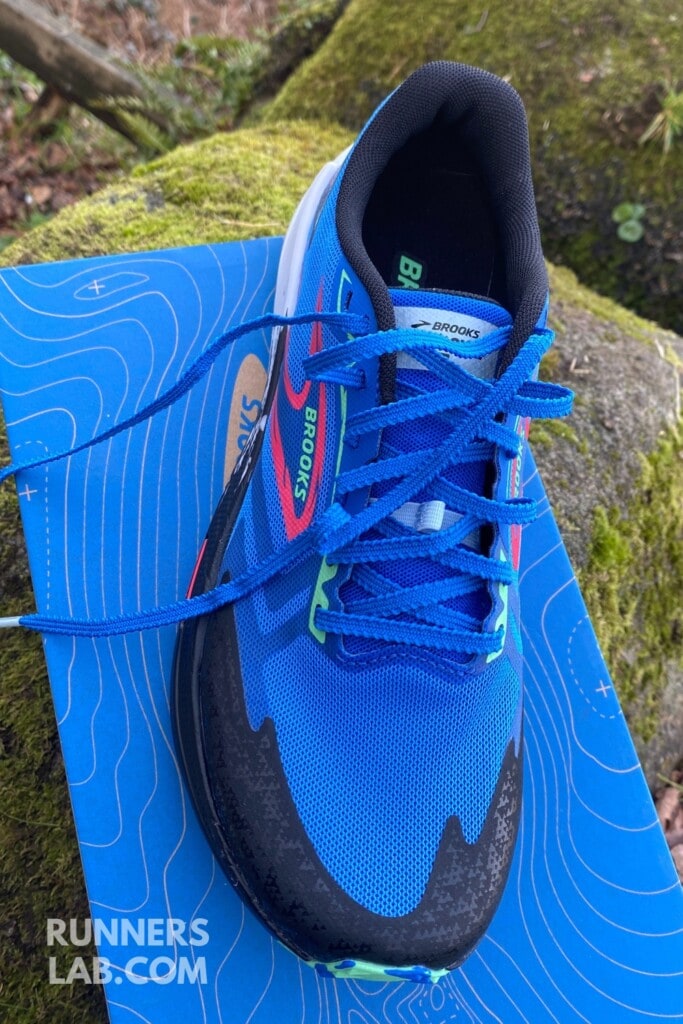
The fit is almost perfect, wrapping snugly around the foot without compressing it. The gusseted tongue is thin and effective–it doesn’t slip with movement. The padded rigid heel counter doesn’t come up very high on the Achilles tendon, but it looks the heel comfortably. Also, the textured laces stay firmly in place, and the pull tab at the back of the shoe is a nice touch.
However, not all runners praised this upper. While some (like myself) appreciate the impeccable fit and lockdown and felt safe at all times, including during faster efforts downhill, others find that the toe box is not roomy enough to be comfortable over long distances.
Overall, the shoe fits true to size, but it may be a bit narrow in the forefoot if you have wide feet.
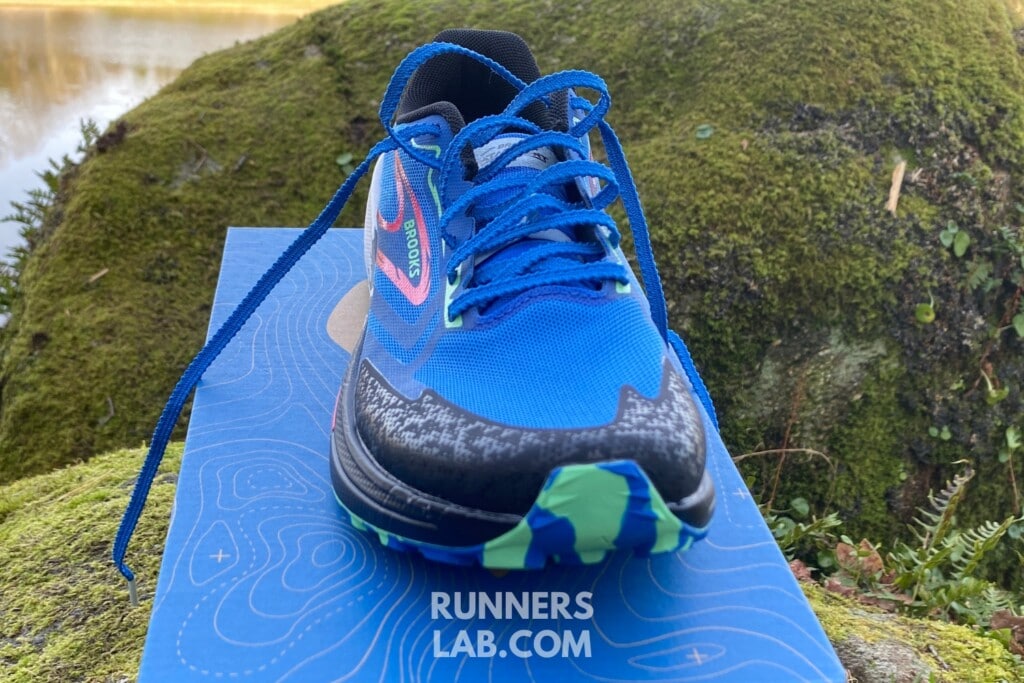
Protection and breathability
The upper is very airy, offering good breathability, while being warm enough in cool temperatures. The toe cap at the front is fairly minimal, but it does the job.
Also, there are the reinforced inserts, which protect against obstacles and provide support. Already mentioned, the Skyvault plate offers extra protection from the sharp sections on your favorite trails.
With all these features, you can take the Brooks Catamount 3 pretty much anywhere.
Use
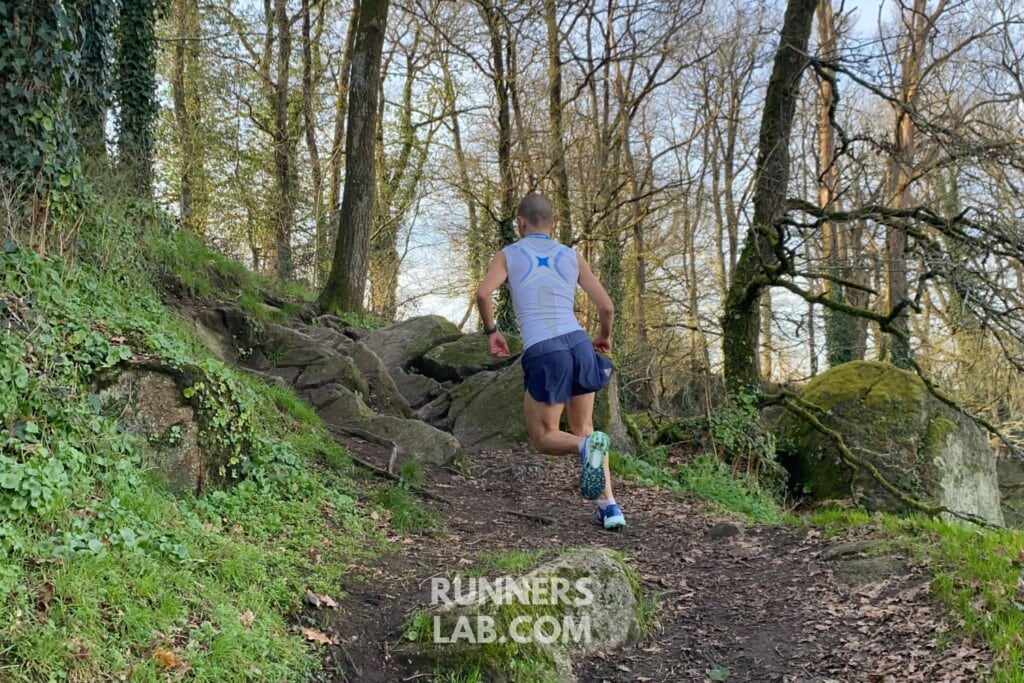
The Brooks Catamount 3 are explosive shoes, ideal for speed trail runs. Yet it’s all-around configuration also makes it a versatile pick for daily training, which is quite surprising considering its light weight.
It’s capable of tackling all types of terrain and run over short or intermediate distances. Its responsiveness makes it an ideal racing partner.
However, as mentioned, unlike what Brooks promises, we don’t think many runners will be able to use these shoes for ultra races beyond 30 mi/50 km.
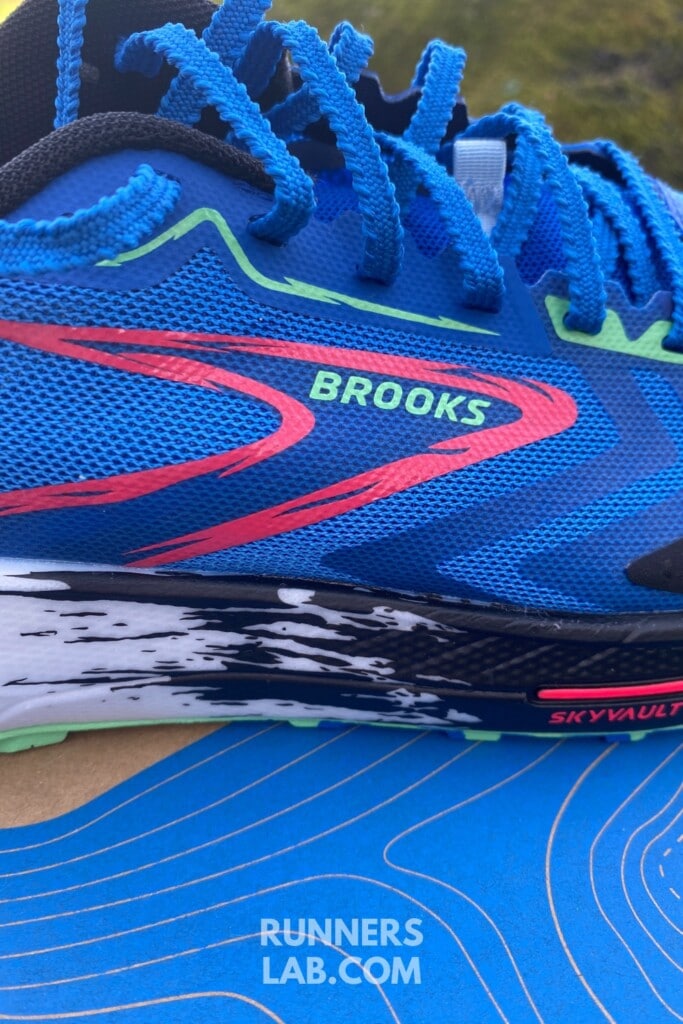
Indeed, whether it’s the lack of toe box space or the moderate stack, it’s not built for long distances. Of course, some trail runners will undoubtedly rise up to the challenge and find them ideal for such endeavors, but we don’t think it will be the majority.
Lastly, mud is not a no-no with these shoes, but deeper lugs would have worked better.
Quality and durability
Testers found the Catamount 3 more durable than the previous version, with robust outsole and upper, making it a value-packed option.
In terms of sustainability, it’s one of the only trail running shoes to be certified carbon-neutral. The upper uses 41.2% recycled materials, diverting 8.29 plastic bottles from landfill for every pair made. What’s more, the Brooks Catamount 3 are vegan shoes.
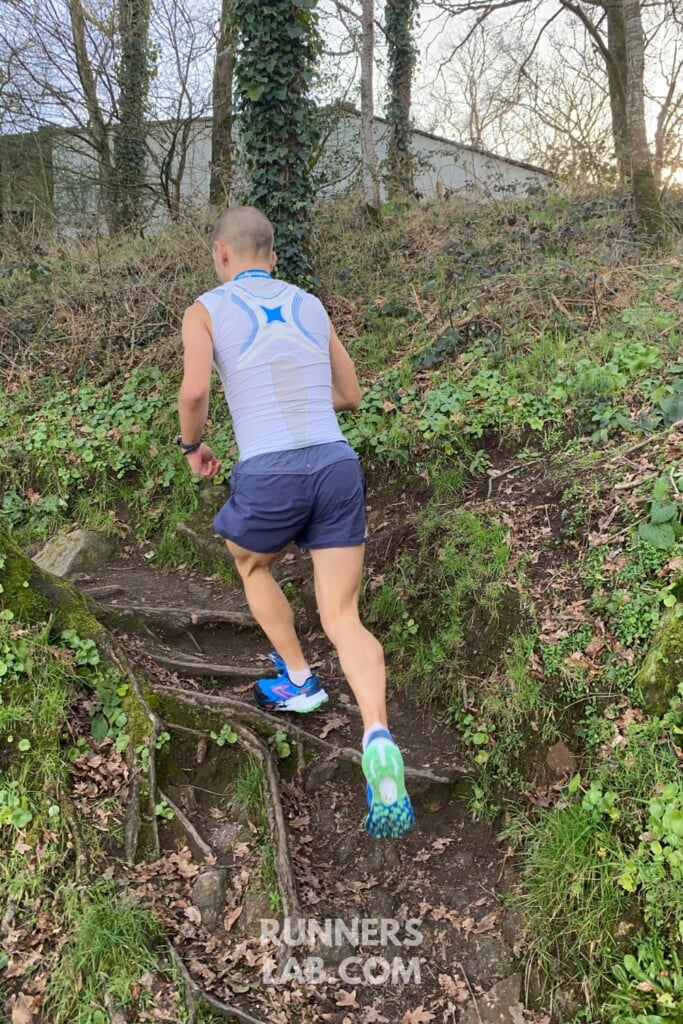
Conclusion
The Brooks Catamount 3 are a highly versatile performance trail shoes that goes head-to-head with the best models of the category. Its excellent responsiveness paired with the brand’s signature comfort makes it a top pick for short to medium racing distances.
Its comprehensive configuration allows you to tackle all terrains confidently and comfortably regardless of your objectives and level.
Facts
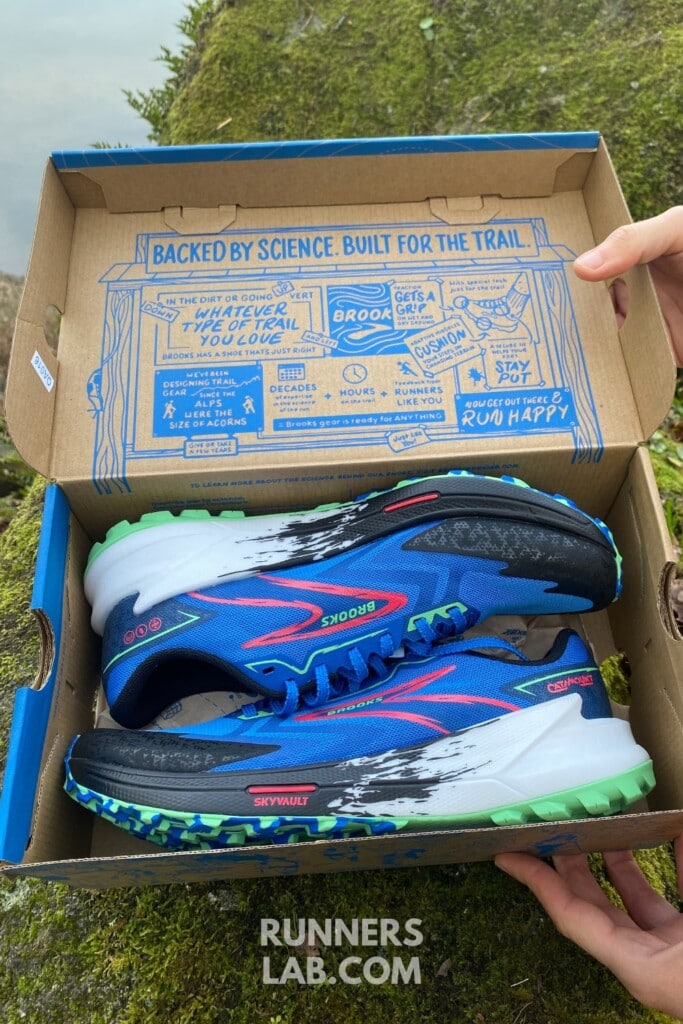
Technical Specs
| Terrain | Trail |
| Pronation type | Neutral |
| Drop | 6 mm |
| Heel height | 28 mm |
| Forefoot height | 22 mm |
| Lugs | 3.5 mm |
| Weight (men) | 246 g/8.7 oz |
| Weight (women) | 238 g/8.4 oz |
| Features | Vegan, Recycled materials, Eco-friendly |
| Athletes | |
| Release year | 2024 |
Cushioning
| Softness | Firm |
| Responsiveness | High |
Technologies
| Outsole | TrailTack Green Rubber |
| Midsole | DNA Flash, SkyVault |
| Upper | Single-layer TPEE mesh, TPU Toecap |
Use
| Speed | Moderate, Fast |
| Distance | Short, Mid |
| Workout | Daily running, Racing |
Comparisons
Brooks Catamount 2
The choice of continuity has been made, and fans of version 2 will not be disoriented. There are, however, a few new features. Firstly, a more responsible design, which modifies the outsole somewhat.
There’s also a new, lighter, more breathable upper, for lighter, more responsive footwear and a better fit.
The Catamount 3 is therefore better than version 2, but the two products are still quite similar, so there’s nothing to stop you buying the Catamount 2 if you see it during promotion periods.

